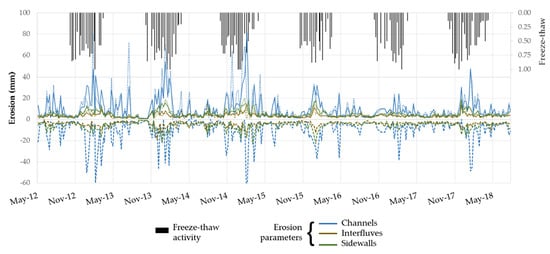Freeze-Thaw Induced Gully Erosion: A Long-Term High-Resolution Analysis
Abstract
:1. Introduction
2. Materials and Methods
2.1. Site Description
2.2. Erosion Parameters
2.3. Freeze-Thaw Variables
2.4. Erosion and Freeze-Thaw Models
3. Results
3.1. Descriptive Statistics
3.2. Erosion Rates
3.3. Comparison of Channels, Interfluves, and Sidewalls
3.4. Erosion Response to Freeze-Thaw Activity
4. Discussion
5. Conclusions
Author Contributions
Funding
Acknowledgments
Conflicts of Interest
References
- Le Roux, J.J.; Sumner, P.D. Factors controlling gully development: Comparing continuous and discontinuous gullies. Land Degrad. Dev. 2012, 23, 440–449. [Google Scholar] [CrossRef]
- Lal, R. Soil erosion and land degradation: The global risks. In Advances in Soil Science: Soil Degradation; Lal, R., Stewart, B.A., Eds.; Springer: New York, NY, USA, 1990; Volume 11, pp. 129–172. ISBN 978-1-4612-3322-0. [Google Scholar]
- Pimentel, D. Soil erosion and the threat to food security and the environment. Ecosyst. Health 2000, 6, 221–226. [Google Scholar] [CrossRef]
- Robertson, G.P.; Broome, J.C.; Chornesky, E.A.; Frankenberger, J.R.; Johnson, P.; Lipson, M.; Miranowski, J.A.; Owens, E.D.; Pimentel, D.; Thrupp, L.A. Rethinking the vision for environmental research in US agriculture. Bioscience 2004, 54, 61–65. [Google Scholar] [CrossRef]
- Parkner, T.; Page, M.J.; Marutani, T.; Trustrum, N.A. Development and controlling factors of gullies and gully complexes, East Coast, New Zealand. Earth Surf. Process. Landf. 2006, 31, 187–199. [Google Scholar] [CrossRef]
- Valentin, C.; Poesen, J.; Li, Y. Gully erosion: Impacts, factors and control. Catena 2005, 63, 132–153. [Google Scholar] [CrossRef]
- Castillo, C.; Gómez, J.A. A century of gully erosion research: Urgency, complexity and study approaches. Earth-Sci. Rev. 2016, 160, 300–319. [Google Scholar] [CrossRef]
- Xu, J.; Li, H.; Liu, X.B.; Hu, W.; Yang, Q.; Hao, Y.; Zhen, H.; Zhang, X. Gully erosion induced by snowmelt in Northeast China: A case study. Sustainability 2019, 11, 88. [Google Scholar] [CrossRef]
- Chaplot, V.; Brown, J.; Dlamini, P.; Eustice, T.; Janeau, J.L.; Jewitt, G.; Lorentz, S.; Martin, L.; Nontokozo-Mchunu, C.; Oakes, E.; et al. Rainfall simulation to identify the storm-scale mechanisms of gully bank retreat. Agric. Water Manag. 2011, 98, 1704–1710. [Google Scholar] [CrossRef] [Green Version]
- Luffman, I.E.; Nandi, A.; Spiegel, T. Gully morphology, hillslope erosion, and precipitation characteristics in the Appalachian Valley and Ridge province, southeastern USA. Catena 2015, 133, 221–232. [Google Scholar] [CrossRef]
- Nearing, M.A.; Jetten, V.; Baffaut, C.; Cerdan, O.; Couturier, A.; Hernandez, M.; Le Bissonnais, Y.; Nichols, M.H.; Nunes, J.P.; Renschler, C.S. Modeling response of soil erosion and runoff to changes in precipitation and cover. Catena 2005, 61, 131–154. [Google Scholar] [CrossRef]
- Baartman, J.E.M.; Jetten, V.G.; Ritsema, C.J.; Vente, J. Exploring effects of rainfall intensity and duration on soil erosion at the catchment scale using openLISEM: Prado catchment, SE Spain. Hydrol. Process. 2012, 26, 1034–1049. [Google Scholar] [CrossRef]
- el Kateb, H.; Zhang, H.; Zhang, P.; Mosandl, R. Soil erosion and surface runoff on different vegetation covers and slope gradients: A field experiment in Southern Shaanxi Province, China. Catena 2013, 105, 1–10. [Google Scholar] [CrossRef]
- Golosov, V.; Koiter, A.J.; Ivanov, M.; Maltsev, K.; Gusarov, A.; Sharifullin, A.; Radchenko, I. Assessment of soil erosion rate trends in two agricultural regions of European Russia for the last 60 years. J. Soils Sediments 2018, 18, 3388–3403. [Google Scholar] [CrossRef]
- Sonneveld, M.P.W.; Everson, T.M.; Veldkamp, A. Multi-scale analysis of soil erosion dynamics in Kwazulu-Natal, South Africa. Land Degrad. Dev. 2005, 16, 287–301. [Google Scholar] [CrossRef]
- Lin, C.; McCool, D.K. Simulating snowmelt and soil frost depth by an energy budget approach. Trans. Am. Soc. Agric. Biol. Eng. 2006, 49, 1383–1394. [Google Scholar]
- Wischmeier, W.H.; Smith, D.D. Predicting Rainfall Erosion Losses—A Guide to Conservation Planning; USDA, Science and Education Administration: Hyattsville, MA, USA, 1978. [Google Scholar]
- Demidov, V.V.; Ostroumov, V.Y.; Nikitishena, I.A.; Lichko, V.I. Seasonal freezing and soil erosion during snowmelt. Eurasian Soil Sci. 1995, 27, 78–87. [Google Scholar]
- Ollesch, G.; Kistner, I.; Meissner, R.; Lindenschmidt, K.E. Modelling of snowmelt erosion and sediment yield in a small low-mountain catchment in Germany. Catena 2006, 68, 161–176. [Google Scholar] [CrossRef]
- van Vliet, L.J.P.; Kline, R.; Hall, J.W. Effects of three tillage treatments on seasonal runoff and soil loss in the Peace River region. Can. J. Soil Sci. 1991, 71, 533–544. [Google Scholar] [CrossRef]
- Lewkowicz, A.G.; Kokelj, S.V. Slope sediment yield in arid lowland continuous permafrost environments, Canadian Arctic Archipelago. Catena 2002, 46, 261–283. [Google Scholar] [CrossRef]
- Kok, H.; McCool, D.K. Freeze thaw effects on soil strength. In International Symposium on Frozen Soil Impacts on Agricultural, Range, and Forest Lands; Cooley, K.R., Ed.; US Army Corps of Engineers Cold Regions Research and Engineering Laboaratory: Spokane, WA, USA, 1990; pp. 70–76. [Google Scholar]
- Formanek, G.E.; McCool, D.K.; Papendick, R.I. Freeze-thaw and consolidation effects on strength of a wet silt loam. Trans. Am. Soc. Agric. Biol. Eng. 1984, 27, 1749–1752. [Google Scholar] [CrossRef]
- Wu, Y.; Ouyang, W.; Hao, Z.; Yang, B.; Wang, L. Snowmelt water drives higher soil erosion than rainfall water in a mid-high latitude upland watershed. J. Hydrol. 2018, 556, 438–448. [Google Scholar] [CrossRef]
- He, H.; Dyck, M.F.; Si, B.C.; Zhang, T.; Lv, J.; Wang, J. Soil freezing-thawing characteristics and snowmelt infiltration in Cryalfs of Alberta, Canada. Geoderma Reg. 2015, 5, 198–208. [Google Scholar] [CrossRef]
- Wang, T.; Li, P.; Ren, Z.; Xu, G.; Li, Z.; Yang, Y.; Tang, S.; Yao, J. Effects of freeze-thaw on soil erosion processes and sediment selectivity under simulated rainfall. J. Arid Land 2017, 9, 234–243. [Google Scholar] [CrossRef] [Green Version]
- Gatto, L.W. Soil freeze-thaw-induced changes to a simulated rill: Potential impacts on soil erosion. Geomorphology 2000, 32, 147–160. [Google Scholar] [CrossRef]
- Iwata, Y.; Hayashi, M.; Hirota, T. Comparison of snowmelt infiltration under different soil-freezing conditions influenced by snow cover. Vadose Zone J. 2008, 7, 79–86. [Google Scholar] [CrossRef]
- Bayard, D.; Stähli, M.; Parriaux, A.; Flühler, H. The influence of seasonally frozen soil on the snowmelt runoff at two Alpine sites in southern Switzerland. J. Hydrol. 2005, 309, 66–84. [Google Scholar] [CrossRef]
- Galang, M.A.; Markewitz, D.; Morris, L.A.; Bussell, P. Land use change and gully erosion in the Piedmont region of South Carolina. J. Soil Water Conserv. 2007, 62, 122–129. [Google Scholar]
- Daniels, R.B. Soil erosion and degradation in the southern Piedmont of the USA. In Land Transformation in Agriculture; Wolman, M.G., Fournier, F.G.A., Eds.; John Wiley & Sons, Ltd.: Hoboken, NJ, USA, 1987; pp. 407–428. [Google Scholar]
- Nandi, A.; Luffman, I. Erosion related changes to physicochemical properties of Ultisols distributed on calcareous sedimentary rocks. J. Sustain. Dev. 2012, 5, 52–68. [Google Scholar] [CrossRef]
- Kincheloe, J.L.; Nandi, A.; Luffman, I.E. Aeolian erosion processes in humid subtropical ultisols in southeastern United States. J. Geogr. Earth Sci. 2018, 6, 19–30. [Google Scholar] [CrossRef]
- Hart, E.A.; Mills, H.H.; Li, P. Measuring erosion rates on exposed limestone residuum using erosion pins: A 10-year record. Phys. Geogr. 2017, 38, 541–555. [Google Scholar] [CrossRef]
- Barnes, N.; Luffman, I.; Nandi, A. Gully erosion and freeze-thaw processes in clay-rich soils, northeast Tennessee, USA. GeoResJ 2016, 9, 67–76. [Google Scholar] [CrossRef]
- Moore, H.L. Drainage problems in carbonate terrain of East Tennessee. In Proceedings of the 27th Annual Highway Geology Symposium, Orlando, FL, USA, 19–21 May 1976; pp. 112–131. [Google Scholar]
- USDA Web Soil Survey. Available online: http://websoilsurvey.nrcs.usda.gov/ (accessed on 20 December 2014).
- IBM Corp. SPSS Statistics for Windows Version 25.0; IBM Corp: Armonk, NY, USA, 2017. [Google Scholar]
- Couper, P.; Stott, T.; Maddock, I. Insights into river bank erosion processes derived from analysis of negative erosion-pin recordings: Observations from three recent UK studies. Earth Surf. Process. Landf. 2002, 27, 59–79. [Google Scholar] [CrossRef]
- Kearney, S.P.; Fonte, S.J.; García, E.; Smukler, S.M. Improving the utility of erosion pins: Absolute value of pin height change as an indicator of relative erosion. Catena 2018, 163, 427–432. [Google Scholar] [CrossRef]
- Matmon, A.; Bierman, P.R.; Larsen, J.; Southworth, S.; Pavich, M.; Caffee, M. Temporally and spatially uniform rates of erosion in the southern Appalachian Great Smoky Mountains. Geology 2003, 31, 155–158. [Google Scholar] [CrossRef] [Green Version]
- Luffman, I.; Nandi, A.; Luffman, B. Comparison of geometric and volumetric methods to a 3D solid model for measurement of gully erosion and sediment yield. Geosciences 2018, 8, 86. [Google Scholar] [CrossRef]
- McConnell, N.R.; Luffman, I.E.; Nandi, A. Time-lapse monitoring of sidewall mass-wasting in a Northeast Tennessee gully. In Proceedings of the Geological Society of America Southeastern Section Annual Meeting, Knoxville, TN, USA, 12–13 April 2018. [Google Scholar]
- He, H.; Dyck, M. Application of multiphase dielectric mixing models for understanding the effective dielectric permittivity of frozen soils. Vadose Zone J. 2013, 12. [Google Scholar] [CrossRef]
- Oztas, T.; Fayetorbay, F. Effect of freezing and thawing processes on soil aggregate stability. Catena 2003, 52, 1–8. [Google Scholar] [CrossRef]
- Edwards, L.M.; Burney, J.R. The effect of antecedent freeze-thaw frequency on runoff and soil loss from frozen soil with and without subsoil compaction and ground cover. Can. J. Soil Sci. 1989, 69, 799–811. [Google Scholar] [CrossRef]
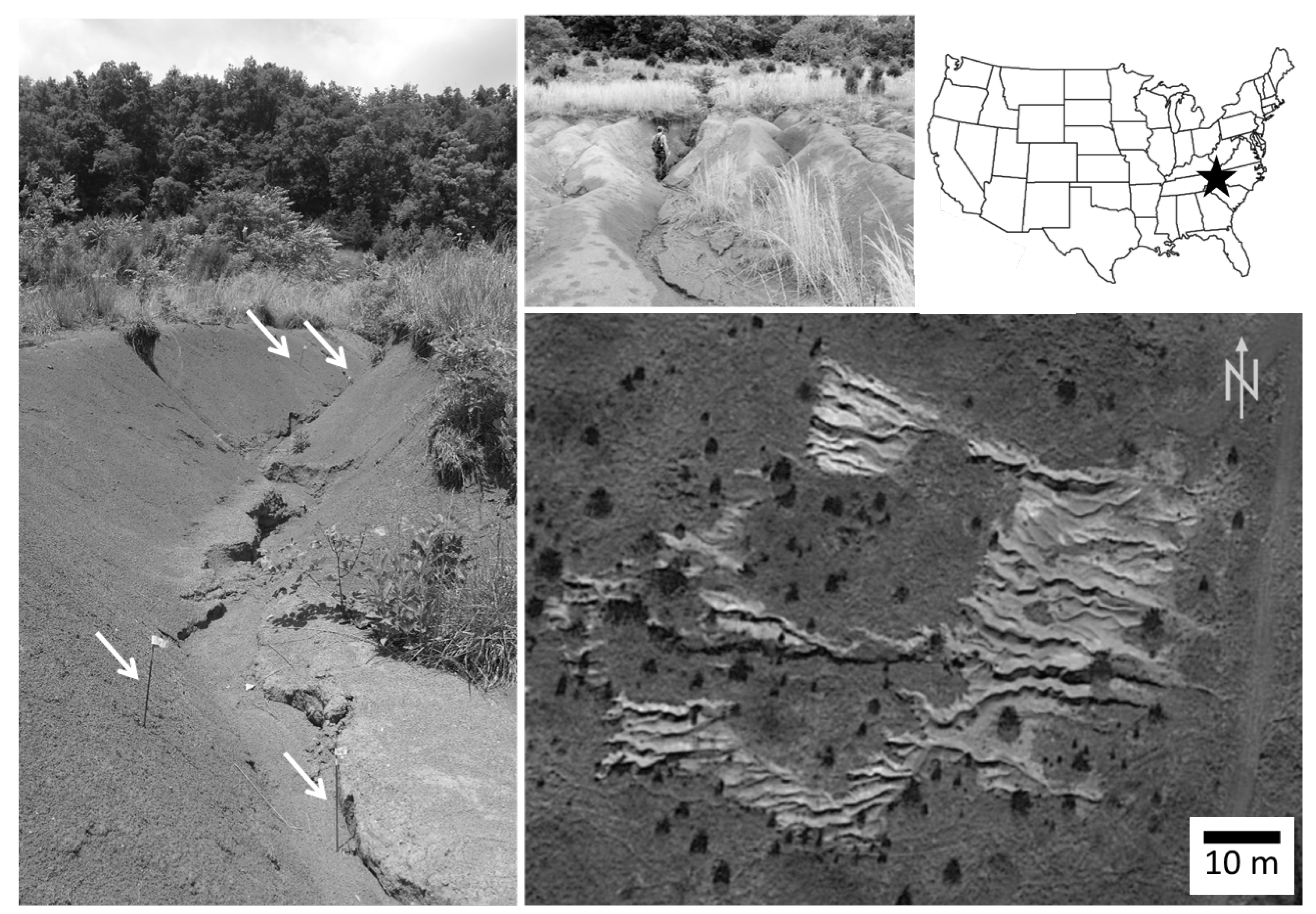
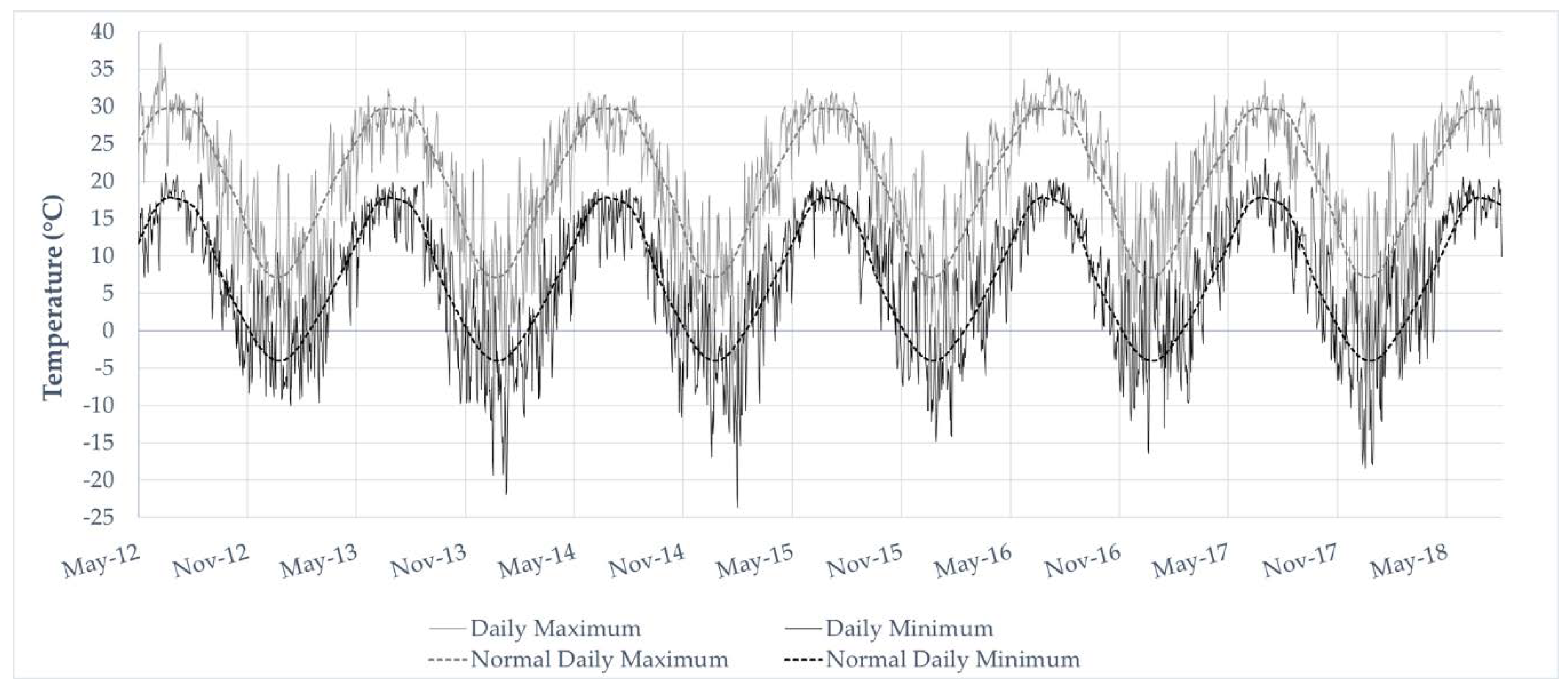
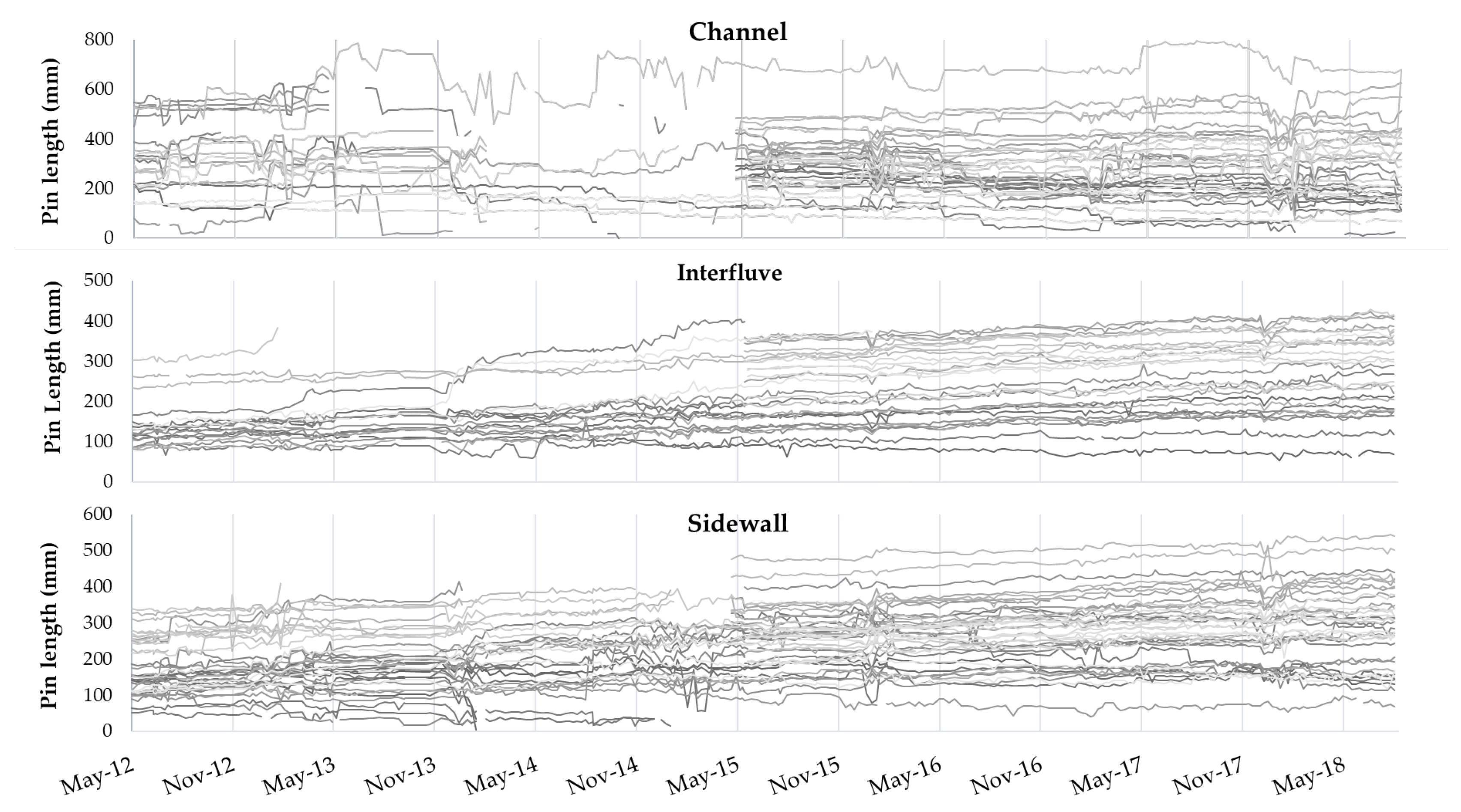
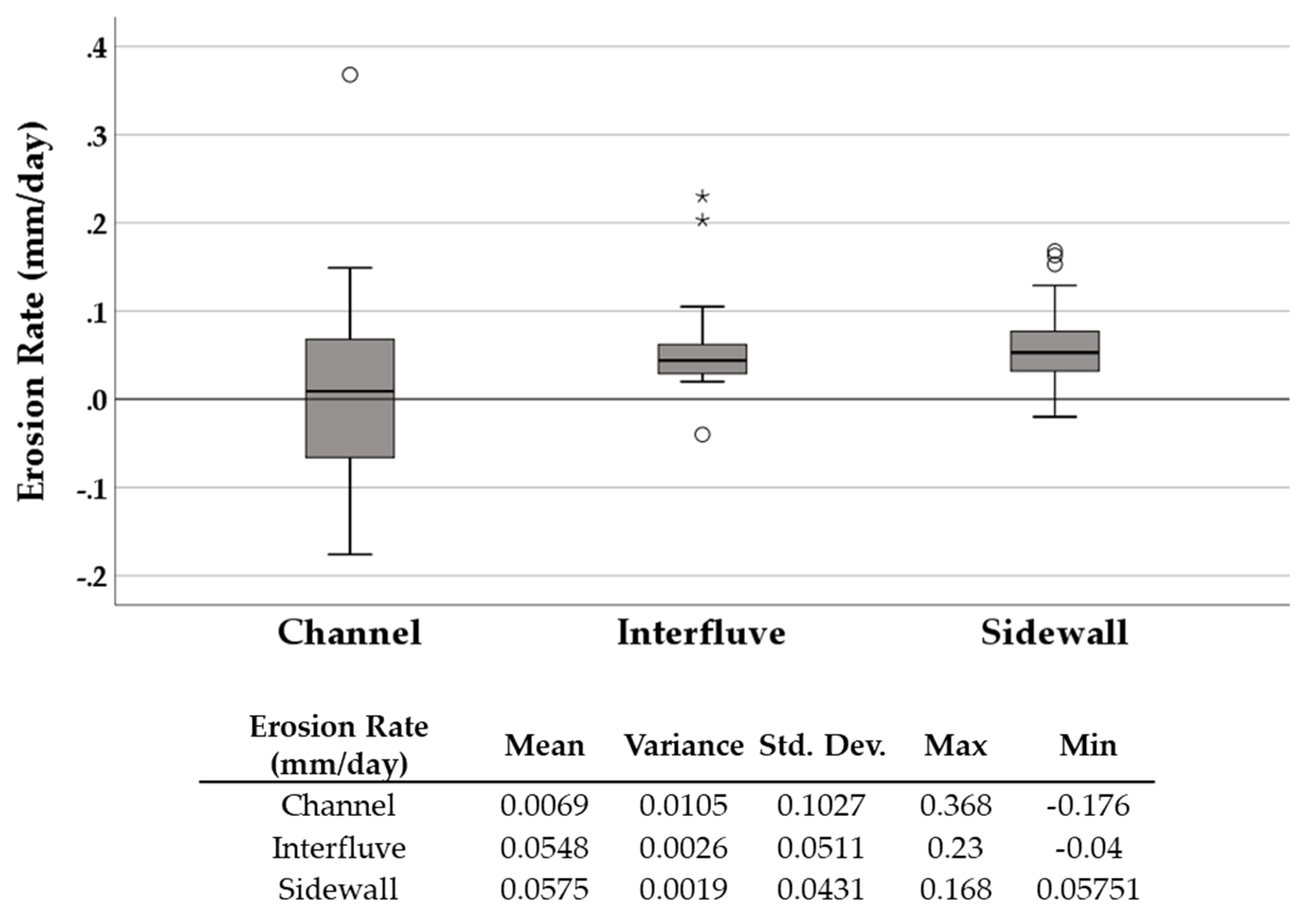
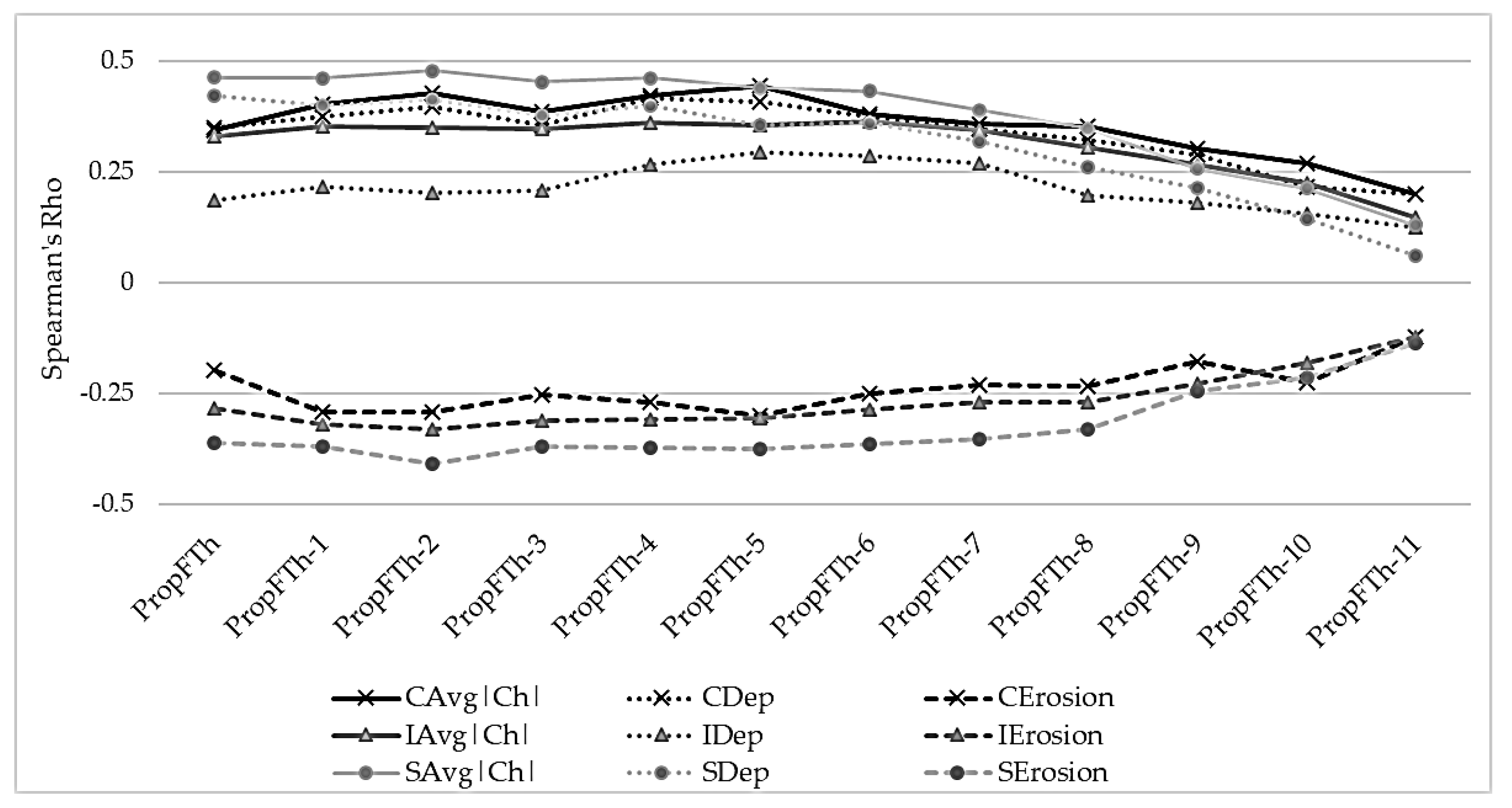
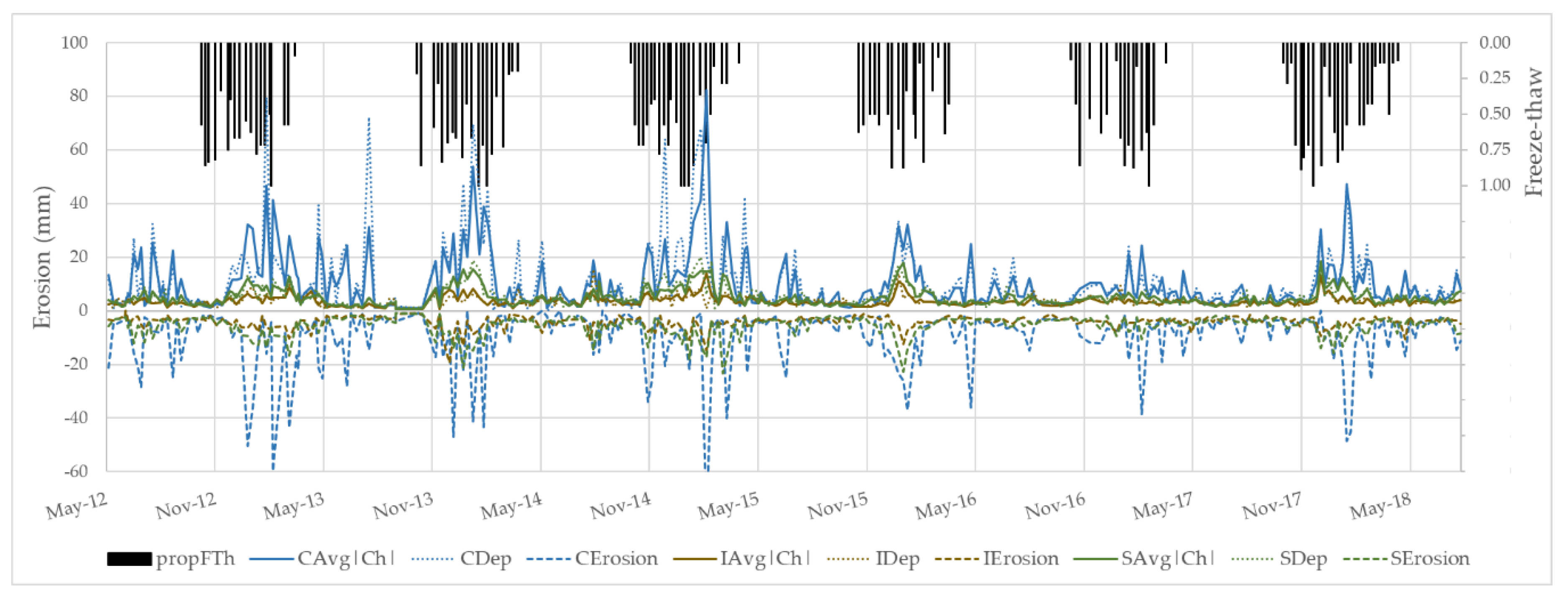
| Date Range | #Days | Data Source |
|---|---|---|
| 18/4/2013–25/4/2013 | 7 | not filled |
| 3/9/2013–10/9/2013 | 7 | not filled |
| 28/7/2014–5/8/2014 | 8 | KTNJONES7 station |
| 14/10/2015–29/10/2015 | 15 | KTNJONES7 station |
| 10/3/2015–27/3/2015 | 17 | KTNJONES7 station |
| 25/5/2017 | 1 | not filled |
| 17/6/2017–18/6/2017 | 1 | not filled |
| 25/6/2017–29/6/2017 | 4 | not filled |
| 16/8/2017 | 1 | not filled |
| 13/3/2018–16/4/2018 | 34 | KTNJONES7 station |
| 27/4/2018 | 1 | KTNJONES7 station |
| 7/6/2018–11/6/2018 | 4 | KTNJONES7 station |
| n | Min | Max | Mean | Std. Deviation | Skewness | Kurtosis | |
|---|---|---|---|---|---|---|---|
| PropFTh | 293 | 0.00 | 1.00 | 0.23 | 0.32 | 0.99 | −0.57 |
| CAvgCh | 294 | −74.00 | 40.40 | 0.22 | 9.19 | −1.28 | 16.84 |
| CAvg|Ch| | 294 | 0.85 | 82.40 | 9.90 | 10.24 | 2.57 | 10.23 |
| CDep | 292 | 1.00 | 79.44 | 10.52 | 12.09 | 2.90 | 10.47 |
| CErosion | 290 | −78.20 | 0.00 | −9.37 | 10.66 | −2.74 | 9.66 |
| IAvgCh | 294 | −14.00 | 9.59 | −0.43 | 2.14 | −0.51 | 6.81 |
| Iavg|Ch| | 294 | 0.56 | 14.11 | 3.53 | 1.77 | 2.16 | 7.99 |
| IDep | 294 | 1.00 | 15.67 | 3.72 | 1.97 | 2.20 | 8.84 |
| IErosion | 294 | −19.33 | 0.00 | −4.08 | 2.30 | −2.33 | 9.06 |
| SAvgCh | 294 | −13.12 | 14.65 | −0.34 | 2.95 | 0.62 | 5.89 |
| Savg|Ch| | 294 | 0.60 | 18.15 | 4.99 | 3.19 | 1.67 | 2.92 |
| SDep | 294 | 1.00 | 20.20 | 5.21 | 3.33 | 1.81 | 4.07 |
| SErosion | 294 | −23.25 | −1.00 | −5.56 | 3.72 | −1.96 | 4.56 |
| Channels | Interfluves | Sidewalls | |
|---|---|---|---|
| AvgCh | - | - | - |
| Avg|Ch| | 0.345 ** | 0.331 * | 0.463 ** |
| Dep | 0.351 ** | 0.185 ** | 0.422 ** |
| Erosion | −0.198 ** | −0.285 ** | −0.363 ** |
| Parameter | Variables Retained | Adjusted R2 |
|---|---|---|
| CAvg|Ch| | PropFTh, PropFTh-2, PropFTh-8 | 0.257 |
| CDep | PropFTh-2, PropFTh-6 | 0.157 |
| CErosion | PropFTh-2, PropFTh-8, PropFTh-10, PropFTh-11 | 0.188 |
| IAvg|Ch| | PropFTh-2, PropFTh-6 | 0.199 |
| IDep | PropFTh-5 | 0.067 |
| IErosion | PropFTh-2 | 0.134 |
| SAvg|Ch| | PropFTh, PropFTh-2, PropFTh-7 | 0.348 |
| SDep | PropFTh, PropFTh-4 | 0.265 |
| SErosion | PropFTh, PropFTh-2, PropFTh-8, PropFTh-11 | 0.259 |
© 2019 by the authors. Licensee MDPI, Basel, Switzerland. This article is an open access article distributed under the terms and conditions of the Creative Commons Attribution (CC BY) license (http://creativecommons.org/licenses/by/4.0/).
Share and Cite
Luffman, I.; Nandi, A. Freeze-Thaw Induced Gully Erosion: A Long-Term High-Resolution Analysis. Agronomy 2019, 9, 549. https://doi.org/10.3390/agronomy9090549
Luffman I, Nandi A. Freeze-Thaw Induced Gully Erosion: A Long-Term High-Resolution Analysis. Agronomy. 2019; 9(9):549. https://doi.org/10.3390/agronomy9090549
Chicago/Turabian StyleLuffman, Ingrid, and Arpita Nandi. 2019. "Freeze-Thaw Induced Gully Erosion: A Long-Term High-Resolution Analysis" Agronomy 9, no. 9: 549. https://doi.org/10.3390/agronomy9090549
APA StyleLuffman, I., & Nandi, A. (2019). Freeze-Thaw Induced Gully Erosion: A Long-Term High-Resolution Analysis. Agronomy, 9(9), 549. https://doi.org/10.3390/agronomy9090549




